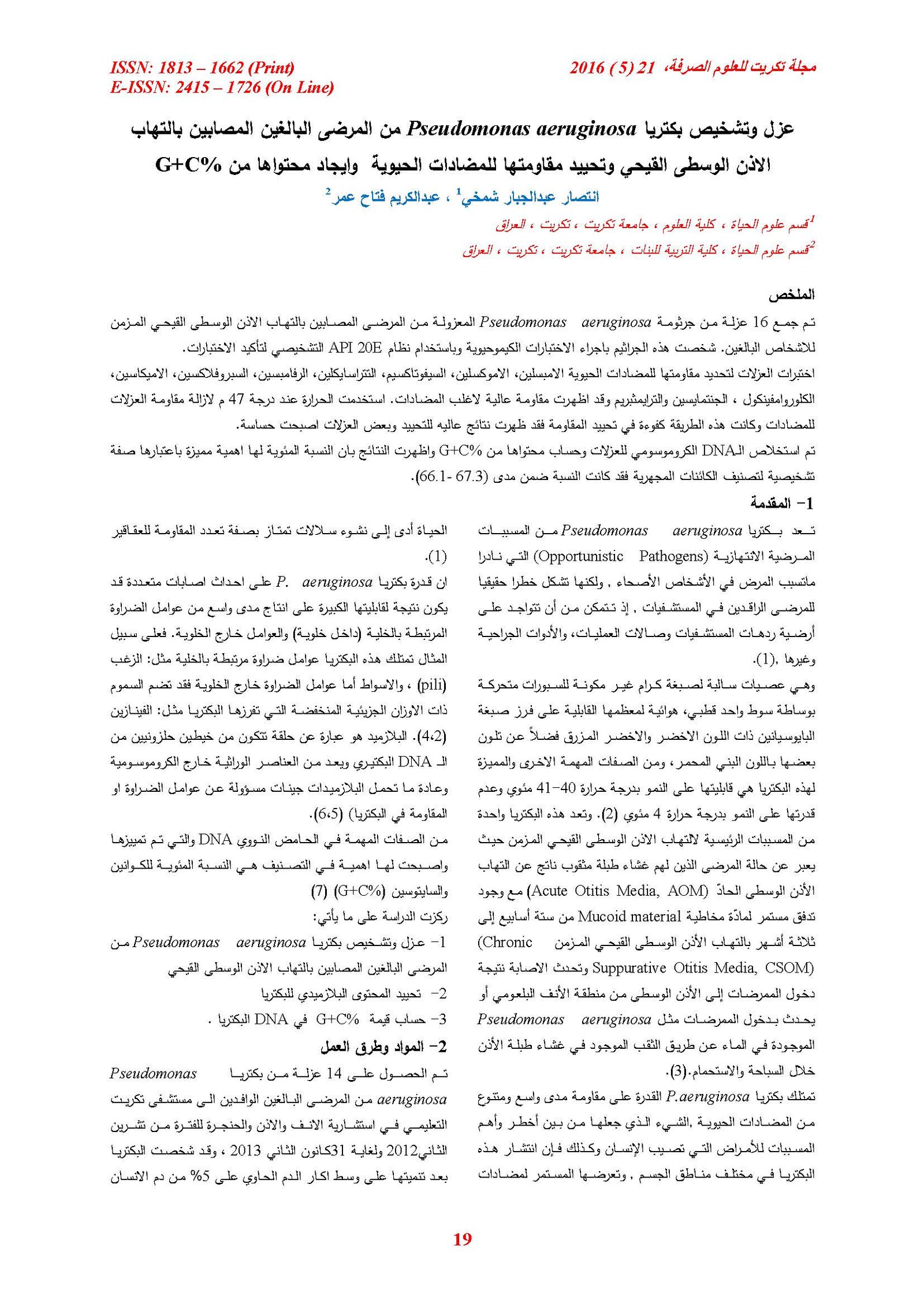Isolation and Identification Bacteria Pseudomonas aeruginosa from adelt patients infected of otitis media and Curing of some Antibiotic Resistance and found content of G+C%
Main Article Content
Abstract
Sixteen isolate of Pseudomonas aeruginosa were collected from patients infected of otitis mediafor adelt people and diagnosed by biochemical teset and API20E these isolate tested for their resistance to Ampicillin, Amoxillin, Chloramphenicol, Trimethoprime, Tetracyclin, Cephotaxim, Amikacin, Gentamycin, Rifampicin and ciproflaxin. For the removal of the resistance against the antibiotics in our isolates plasmid curing experiment was performed by using physical agent (elevated temperature). The results indicated that high temperature (47°C) was efficient to cure all the plasmids, and some isolates became sensitive to antibiotics. The extraction of chromosomal DNA was done to estimate the mol% of G+C of DNA content to all isolates the results the results showed that it was a taxonomic importance and it was at range (66.1- 67.3%).
Article Details

This work is licensed under a Creative Commons Attribution 4.0 International License.
Tikrit Journal of Pure Science is licensed under the Creative Commons Attribution 4.0 International License, which allows users to copy, create extracts, abstracts, and new works from the article, alter and revise the article, and make commercial use of the article (including reuse and/or resale of the article by commercial entities), provided the user gives appropriate credit (with a link to the formal publication through the relevant DOI), provides a link to the license, indicates if changes were made, and the licensor is not represented as endorsing the use made of the work. The authors hold the copyright for their published work on the Tikrit J. Pure Sci. website, while Tikrit J. Pure Sci. is responsible for appreciate citation of their work, which is released under CC-BY-4.0, enabling the unrestricted use, distribution, and reproduction of an article in any medium, provided that the original work is properly cited.
References
1- Greenwood, D.; Finch, R.; Davey, P. and Wilcox, M. (2007). Antimicrobial chemotherapy. Oxford University Press, New York.
2- Choi, J. Y.; C. D. Sifri; B. C. Goumnerow; L. G. Rahme; F. M. Ausubal and S. B. Colderwood. (2002). Identification of Virulence Genes in a pathogenic Strain of Pseudomonas aeruginosa by representational Difference Analysis. J. Microbiology. 184 : 952 – 961.
3- AL-Tallah, M.S. (2000). Microbiology of chronic suppurative otitis media withcholesteatoma. Saudia Medical. J. vol, 21(10);p924-927. 599 -606.
4- Wick, M. J., D. W. Frank, D. G. Storey, and B. H. Iglewski. 1990. Structure, function, and regulation of Pseudomonas aeruginosa exotoxin A. Annu. Rev. Microbiol. 44:335–363.
5- Kaye, K.S.; Cosgrove, S.; Marris, A.; Eliopoules, G.M. and carmeli, y. (2000). Risk factors for emergence of resistance to broad spectrum cephalosporins among Enterobacter SPP. J. antimicrob. agent. Chemother., 45(9): 2628-2630.
6- Levy, S. B. (2001). The 2000 Garrod lecture. Factors impacting on the problem of antibiotic resistance. J. Antimicrob. Agents Chemother., 49 (1): 25-30.
7- Johnson, J.L. (1981) Genetic characterization, p. 450472. In: P. Gerhardt, R.G.E. Murray, R.N. Costilow, E.W. Nester, W.A. Wood, N.R. Krieg, and G.B. Phillips (ed.), Manual of methods for general bacteriology. American Society for Microbiology, Washington, D.C.
8- Mahon, C.R.; Lehman, D.C.; Manuselis, G.(2007). Textbook of Diagnostic Microbiology. 3rd ed., Saunders Elsevier, USA.
9- Atlas, R.M. (1995). Principle of microbiology. 1sted.,Mosby-Year book, Inc., St. Louis, U.S.A.
10- Maniatis, T.; Fritsch, E. F.; Sambrook , J. and Molecular, C. (1982). Alaboratory manual cold spring Harbor Laboratory , New York.
11- Baldwin, J.N. and Strickl and, R.H. (1969). Some properties of the Beta-lactamase genes in Staphylococcus epidermidis. J. Appl. Microbiol., 18: 628-630.
12- Cesarone, C.F.; Bolognesi, C.; Santi, L. (1979) Improved microfluorometric DNA determination in biological material using 33258 Hoechst. NCBI Anal Biochem 100(1):188-97.
13- Radi, R. O; Rahman, F.H. (2010). Study the effects of ethidium bromide, SDS. and elevated temperature on stability of multiple antibiotic resistances plasmid of Pseudomonas aerugenosa. Iraq .J .Biotech . 9 (4) :797-811.
14- Garvie, E.I. (1974) Lactic dehydrogenases of strains of the Genus Leuconostoc. J Gen Microbiol 58:85-94.
15- de Ley, J. (1969) Reexamination of the association between melting point, buoyant density and chemical base composition of deoxyribonucleic acid. J Bacteriol 101:738-754.
16- Tenover, F. C. and McGowan, J.E.(1996). Reasons for the emergence of antibiotics resistance Am. G. Med. Sci. , 311-9.
17- Mazal. D. and Davies, J. (1999) Intibiotic resistance in microbes. Cell. Mol. Life. 56:742.
18- Kheder, A.K. (2002). Studies on antibiotic resistance by plasmid of Pseudomonas aerugenosa . Ph.D. thesis. College of education. University of Salahaddin, Iraq.
19- Ahmed, A. D. (2005) Curing of some Antibiotic Resistance in Pseudomonas aeruginosaIsolates by the Action of Sodium Dodecyl Sulphateand Elevated Temperature, Raf. Jour. Sci., Vol.16, No.7 Biology, Special Issue, pp.34-39,
20- Sambrook, J.; Fritsch, E.; Maniatis, T. (1989) Molecular and laboratory manual. 2nd ed. Cold Spring Harbour Laboratories New York.
21- Lozano-A, L.C.; Bautista, M.A.; Dussan-G, J. and Vives-Flórez1, M.J. (2008) DNA Extraction from Heavy oil contaminated Microcosms and Rpob gene PCR Amplification. Actual Biol 30 (88): 7-14.
22- Marmur, J., and Doty, P. (1962) Determination of the base composition of deoxyribonucleic acid from its thermal denaturation temperature. J MolBiol 5:109-118.
23- Holt, J.C.; Krieg, N.R.; Sneath, P.H.A.; Stahley, J.T. and William, S.T. (1994). Bergy's Manual Of Determinative Bacteriology. 9th ed., USA.
